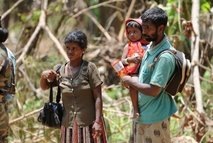 The UN’s humanitarian chief was due in Sri Lanka on Saturday as international concern over civilians trapped in the island’s war zone fuelled a White House call for an immediate ceasefire.
The UN’s humanitarian chief was due in Sri Lanka on Saturday as international concern over civilians trapped in the island’s war zone fuelled a White House call for an immediate ceasefire.
John Holmes’ three-day mission will focus on pushing the government to facilitate humanitarian missions in and around the conflict zone and to allow proper access to tens of thousands of displaced civilians, the UN said.
The plight and suffering of those caught in the fighting between government troops and Tamil Tiger rebels prompted US President Barack Obama’s administration on Friday to urge an end to hostilities.
"We call on both sides to stop fighting immediately and allow civilians to safely leave the combat zone," the White House said in a statement.
Sri Lanka has so far resisted all calls to halt an offensive that is now on the brink of wiping out the Liberation Tigers of Tamil Eelam, or LTTE, who have been fighting for an independent Tamil homeland since 1972.
The Tigers, once one of the most feared guerrilla organisations in the world, have seen their territory shrink to a sliver of land on the northeast coast estimated to measure 10 square kilometres (about four square miles).
The White House specifically demanded an end to any military shelling in a designated "safe zone" and access for aid groups and journalists to civilians who have escaped.
The LTTE issued their own call for foreign intervention, warning of "imminent" starvation among civilians and even suggesting that the situation could deteriorate into a crisis as appalling as that in the Darfur region of Sudan.
It is not clear how many people are trapped in the small rebel-held area. The UN has estimated the number at 50,000, while the government says it is closer 15,000-20,000. The Tigers insist the real figure is 165,000.
Sri Lanka’s military success has come at a huge cost to civilians, rights groups say, with the UN estimating as many as 6,500 non-combatants may have been killed and another 14,000 wounded in the fighting so far this year.
Independent verification of casualty figures is almost impossible as journalists have long been barred from the island’s north, except when under strict supervision on trips organised by the military.
The White House statement warned that the government risked sowing the seeds of future ethnic conflict on the Sinhalese-majority island.
"It would compound the current tragedy if the military end of the conflict only breeds further enmity and ends hopes for reconciliation and a unified Sri Lanka in the future," the White House said.
Around 110,000 civilians managed to get out of the battle zone earlier in the week, overwhelming the government authorities handling relief operations.
The Sri Lankan government has been blocking most aid agencies from working in the war-torn north for months, and accuses UN agencies and NGOs of supporting the Tamil Tigers.
Nevertheless, Sri Lanka’s Human Rights Minister Mahinda Samarasinghe welcomed the visit by Holmes, his second in as many months.
"We hope to have a constructive discussion with him," Samarasinghe said.
(For updates you can share with your friends, follow TNN on Facebook and Twitter )
